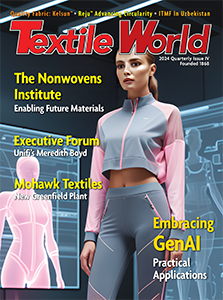By Janet Bealer Rodie, Contributing Editor
DuPont Microcircuit Materials, Research Triangle Park, N.C., has launched the first products in a suite of stretchable conductive inks and related materials that can be printed on a textile to produce smart activewear and health- monitoring clothing and other smart textiles. The company reports the new materials provide a durable, comfortable, flexible, cost-competitive, manufacturing-ready alternative to electronically conductive yarns, polymers and other materials.
Currently, a silver-based conductive ink and a dielectric encapsulant are available, and other inks and sensors are in development. They are applied to thin thermoplastic polyurethane (TPU) film that is then laminated onto the fabric. According to Dr. Michael Burrows, segment manager, DuPont Microcircuit Materials, the inks withstand repeated elongation and continue to show strong performance after 100 wash cycles when printed onto the TPU film.

Thin thermoplastic polyurethane films printed with DuPont Microcircuit Materials’ stretchable conductive inks are bonded strategically to the inside of a fitness shirt (below) to provide biometric function.

DuPont launched its stretchable electronic inks at Printed Electronics USA 2014, held recently in Santa Clara, Calif., where it displayed a biometric fitness shirt incorporating the inks. The shirt was developed in collaboration with Maxim Integrated, a San Jose, Calif.-based electronics provider; and Finland-based Clothing+, which integrates flexible circuits into textile structures and designed the shirt. The TPU film was provided by Bemis Associates Inc., a Shirley, Mass.-based manufacturer of adhesive materials and tapes. Other research collaborators include North Carolina State University (NCSU) and the National Science Foundation Nanosystems Engineering Research Center on Advanced Self-Powered Systems of Integrated Sensors and Technologies (ASSIST) at NCSU.
In the shirt displayed at Printed Electronics, electronic inks are used with an interconnect type of application along with some sensors to enable continuous monitoring of heartbeat and breathing rates as well as calories burned and stress levels, explained Steven Willoughby, marketing manager, DuPont Microcircuit Materials. “These materials are bonded to the inside of the shirt in strategic places,” he said. “They are hooked up to a small, detachable battery module, which also incorporates a couple of other sensory elements as well as a wireless communication element that will communicate with, for example, a smartphone.”
Willoughby said the new inks received a very positive response from show attendees. “Customers were excited by the potential and found it very compelling to see a real, functional example in the shirt, as well as to be able to feel and touch the materials,” he said, adding that customers are actively working on potential end products.
Some customers also are working to print the inks directly onto a fabric, although there remain some challenges with the choice of substrate and wash durability.
Willoughby also noted that the materials can be screen printed onto the laminate, enabling high-volume, low-cost printing. “All the different elements integrate into existing manufacturing processes,” he added. “It’s a fairly elegant, practical way to create a thin, form-fitting circuit and make a really comfortable garment.”
For more information about DuPont Microcircuit Materials’ stretchable electronic inks, contact Noelle D. Hagen, +919-248-5062; noelle.d.hagen@dupont.com.
January/February 2015




